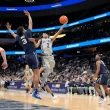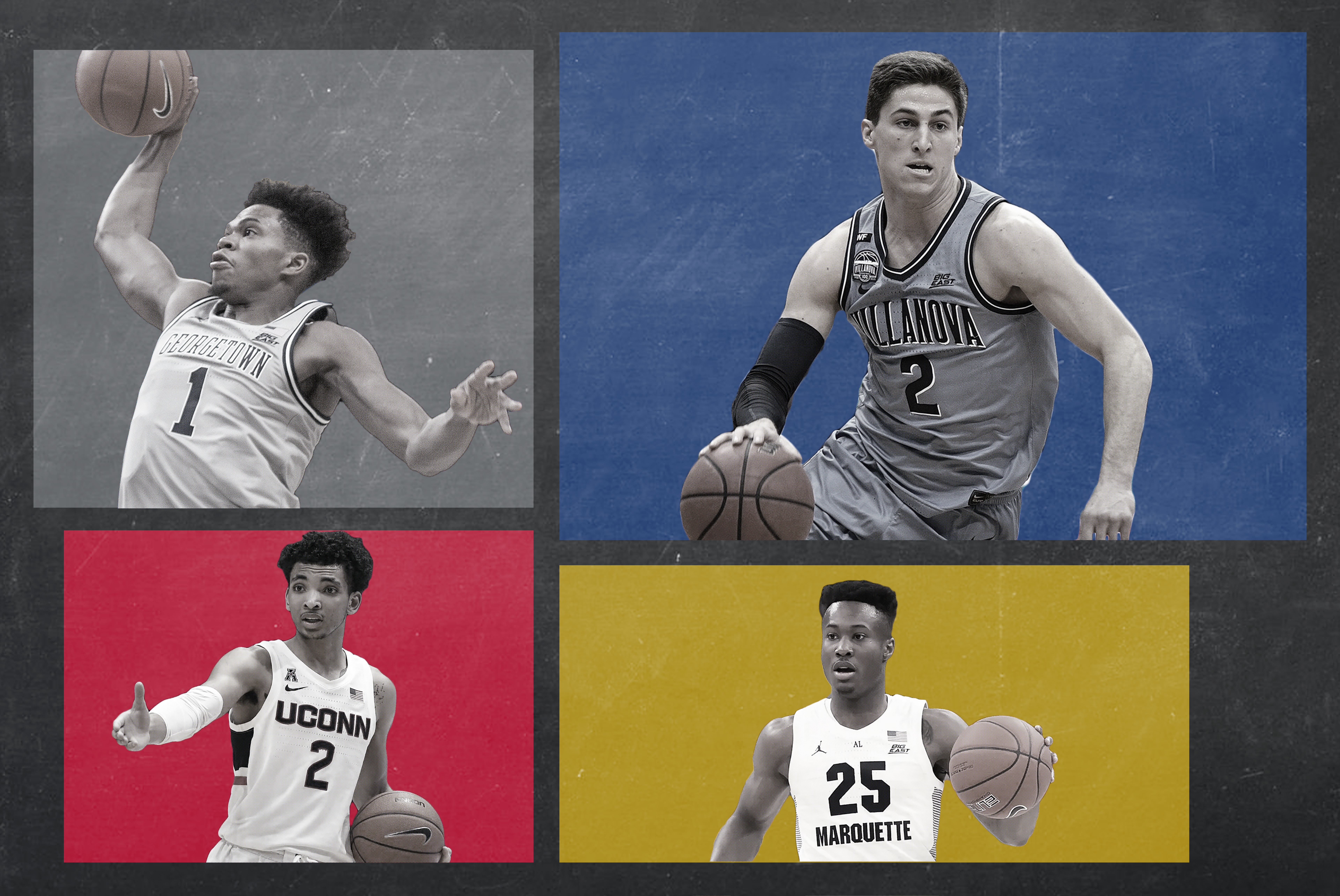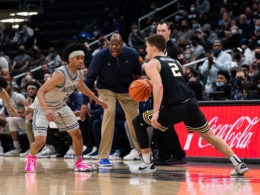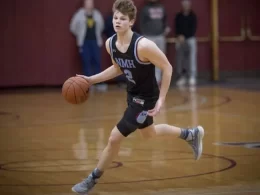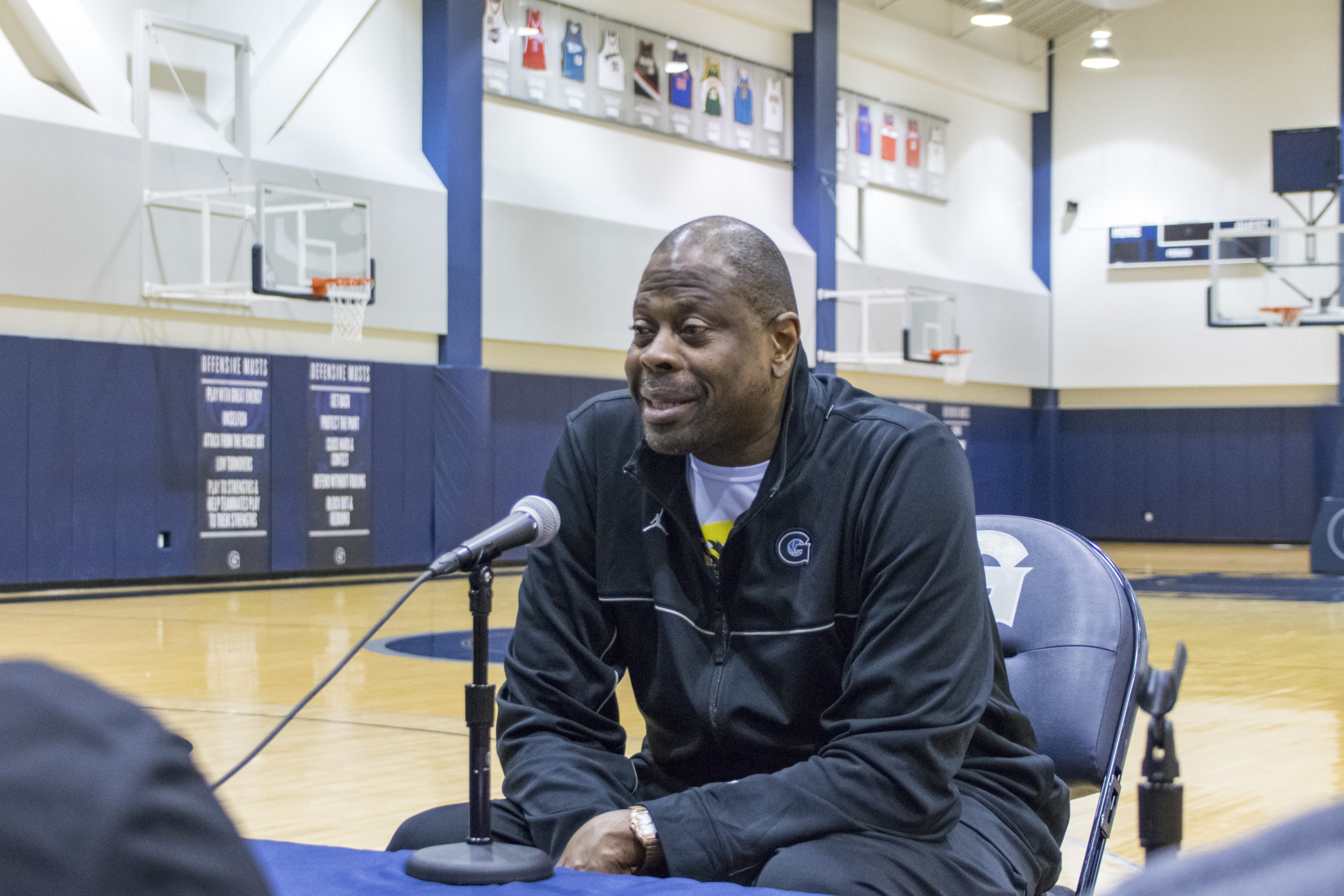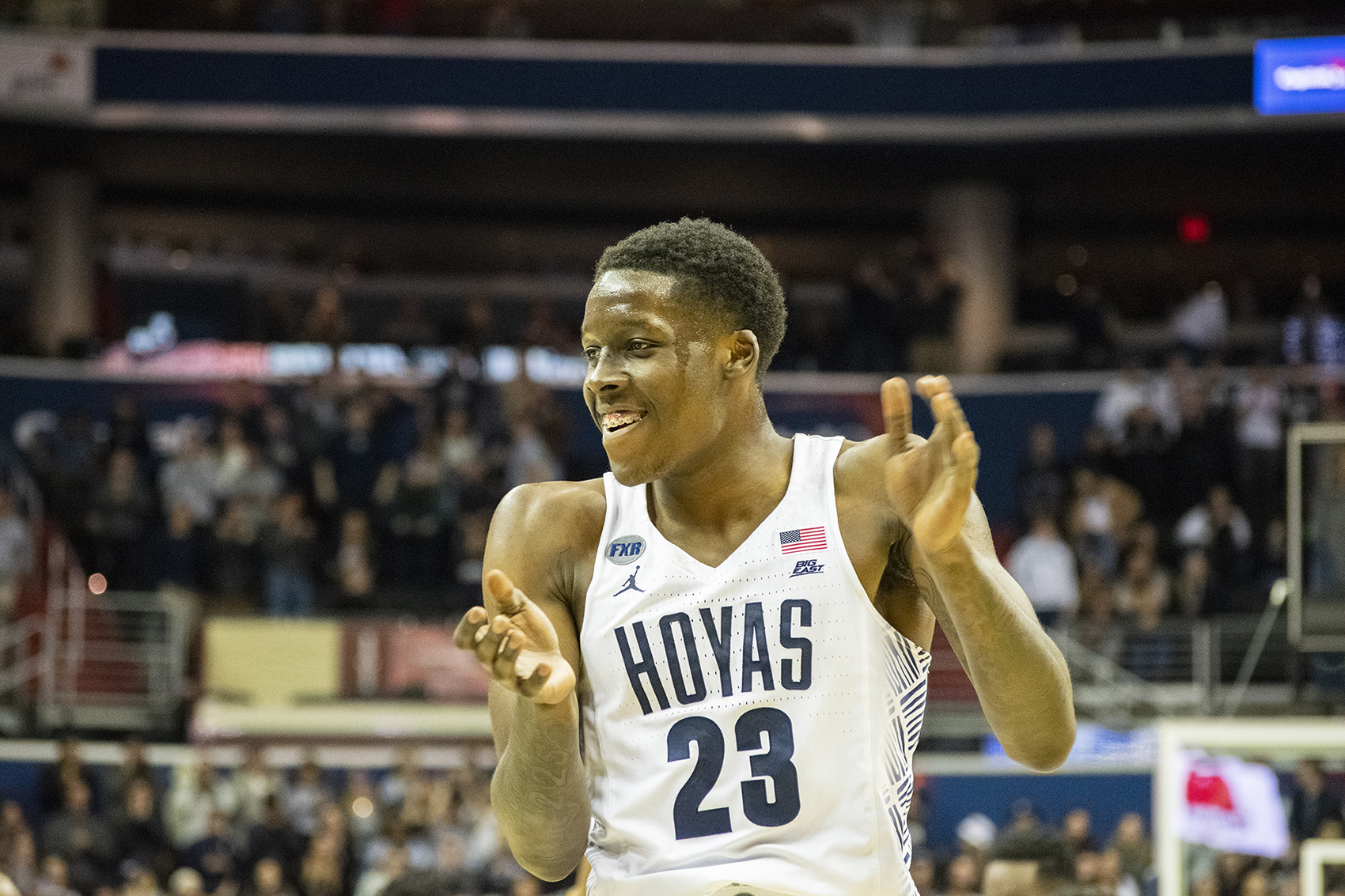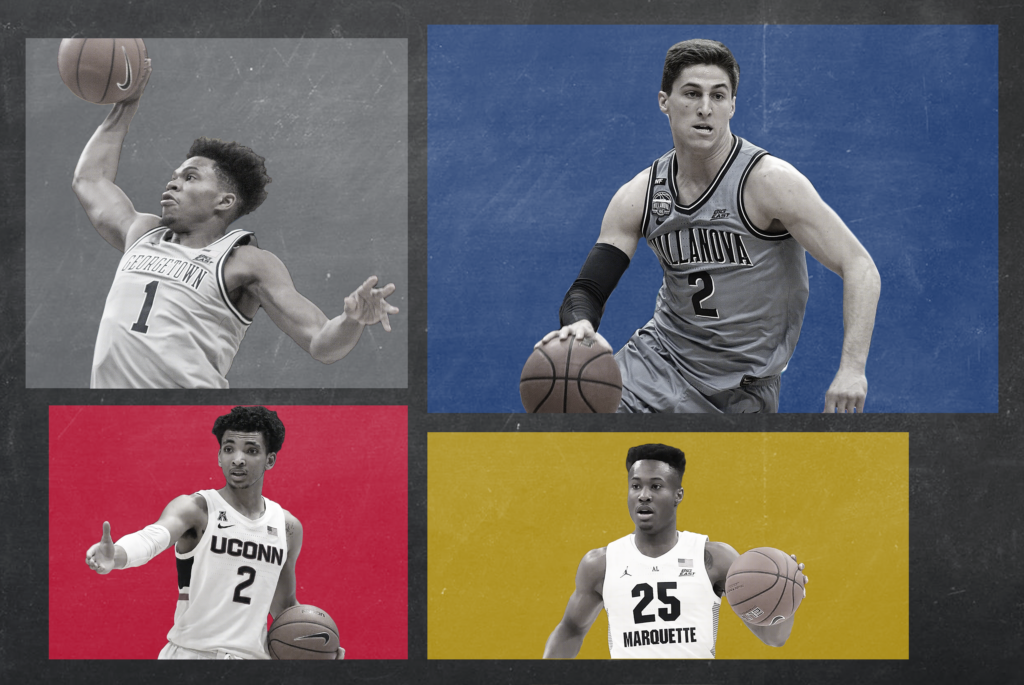
It’s been a long time since we’ve seen Big East basketball in action. The Big East, along with every other conference in the NCAA, cancelled their conference tournament last March due to COVID-19. The conference will expand to 11 teams this season as the UConn Huskies return into the fold looking to shake things up. Below is a preview of each Big East team, ranked in my projected order of finish. Check back later this week for the rest of our staff’s Big East picks!
1. Villanova
(Last season: 24-7 overall, 13-5 conference, ranked #10)
Villanova has been the standard in the Big East for a few years now, consistently remaining a top program in the country despite repeated turnover of talented players. Last year’s leading scorer Saddiq Bey was drafted to the Detroit Pistons but Jay Wright’s squad isn’t expected to miss a beat. Villanova is currently projected as the 3rd best team in the country according to the AP Top 25 preseason poll and is going to depend on senior leader Collin Gillespie to keep them as one of the top teams in college basketball. Gillespie, who won a championship with the Wildcats in 2018 and was named to the All-Big East Second team last season, averaged 15.1 points, 3.7 rebounds, and 4.5 assists per game last year as the team’s floor general. In addition to Gillespie, Villanova returns three other players who averaged over 10 points per game last year: Justin Moore (11.3 ppg, 3.1 rpg), Jermaine Samuels (10.7 ppg, 5.5 rpg), and Jeremiah Robinson-Earl (10.5 ppg, 9.4 rpg). Moore and Robinson-Earl were also unanimously selected to the Big East All-Freshman Team last year. Jay Wright also continues to bring in new talent with the signings of highly ranked 4-star recruits Trey Patterson (forward) and Nnanna Njoku (center). Consistency is key here, as Jay Wright has kept the Wildcats among college basketball’s elite for the last several years. With most of last year’s core returning, Villanova again looks poised to be the early favorite to win the Big East.
2. Creighton
(Last season: 24- 7 overall, 13-5 conference, ranked #7)
Creighton entered last year’s Big East tournament as the number one seed due to their lights out 3-point shooting, and comes into this season with big expectations, ranked 11th in the country in the AP preseason poll. Last year’s leading scorer Ty-Shon Alexander signed a two-way contract with the Phoenix Suns,, but the Bluejays feel confident in their other star guard, junior Marcus Zegarowski. Zegarowski averaged 16.1 points, 3.8 rebounds, and 5 assists per game last year and was unanimously selected to the All-Big East Second Team. With the absence of Alexander, Zegarowski’s skills will be front and center for the Bluejays, and he looks to be one of the top players in the conference this year. Another notable returner for Creighton is sharpshooting senior Mitch Ballock who averaged 11.9 points per game last year and shot a scorching 43.5% from behind the arc. The Bluejays are looking to prove themselves on the national stage this year, and have their eyes set on once again finishing with the best record in the Big East.
3. Seton Hall
(Last Season: 21-9 overall, 13-5 conference, ranked #15)
Seton Hall had a great season last year behind star guard Myles Powell and looked poised to make a deep run in the NCAA tournament before the season was cancelled . Powell’s leadership and impressive scoring will be difficult to replace this season, as he and fellow senior Quincy McKnight have now graduated, but the Pirates did land coveted Harvard transfer Bryce Aiken to run their backcourt. Aiken averaged 16.7 points per game last season and brings veteran experience to Seton Hall’s backcourt as a fifth year transfer. Aiken will be paired alongside returning junior Jared Rhoden, who averaged 9.1 points and 6.4 rebounds per game last season. Another important returner for Seton Hall is senior big man Sandro Mamukelashvili – also known as Mamu. Standing at 6’11”, Mamu averaged 11.9 points and 6 rebounds per game for the Pirates while shooting 54% from the field . Replacing a star like Powell is tough, but the Pirates find themselves with a dangerous one-two punch centered on a proven veteran scorer in Aiken combined with a dominant big man in Mamu. Seton Hall should remain competitive with the top of the Big East this year, but it remains to be seen if they have enough to snatch the crown.
4. Providence
(Last season: 19-12 overall, 12-6 conference)
Providence was the Big East surprise last season, ending the season ranked fourth in conference play on a hot streak led by All-Big East Second Team selection Alpha Diallo. Diallo won’t be returning this season, but Providence scored largely by committee last year, which should make it easier to replace him and fellow graduate Luwane Pipkins. The Friars are returning 3 key players from last year’s core in David Duke (12 ppg, 4.2 rpg, 3.1 apg), Nate Watson (9 ppg, 4.6 rpg), and AJ Reeves (7.4 ppg, 3.1 rpg, 1.2 apg) who are looking to continue their upwards trajectory. Duke especially will be looking to capitalize on more scoring opportunities in the absence of Diallo this season. Providence will have to rely on him to prove that last season wasn’t a flash in the pan and that the Friars are a legitimate contender in the Big East.
5. UConn
(Last season: 19-12 overall, 10-8 in the American Athletic Conference)
The biggest offseason news in the Big East is the return of UConn into the fold, after initially leaving in 2013 due to a desire to play in a competitive college football conference. While the AAC is not considered to be the same level of strength as the Big East, UConn played well last year, finishing fifth in their conference when the season ended. Last year’s leading scorer Christian Vital has graduated, but UConn’s future is bright thanks to sophomore James Bouknight, who averaged 13.4 points, 4.1 rebounds, and 1.3 assists per game last season and was named to both the AAC All-Freshman Team and the All-Conference Third Team. The Huskies will also be looking to senior forwards Tyler Polley (9.5 ppg, 3.2 rpg) and Josh Carlton(7.8 ppg, 6.1 rpg) to continue providing key contributions and leadership. Finally, Coach Dan Hurley additionally signed two 4-star recruits, forward Andre Jackson and center Adama Sanogo. The bottom line is that UConn is a deep team this year with a real chance of shaking up the current Big East hierarchy. The Huskies are starting a step behind the 8 ball this year as the sole new member to the conference, but don’t expect that to hold them back.
6. Marquette
(Last season: 18-12 overall, 8-10 conference)
Marquette will be entering uncharted territory this season as they will have to figure out how to move forward without prolific scorer Markus Howard. Howard led not only Marqutte, but the entire NCAA in scoring last season, averaging 27.8 points per game. Replicating this level of scoring is practically impossible – their highest scoring returning player is Koby McEwen, who averaged 9.5 points along with 5 rebounds and 3.2 assists per game. Marquette has high hopes for 4-star freshman point guard Stevie Mitchell to eventually fill the Howard void, but it’s clear that Howard’s scoring will have to be replaced by committee. Another notable returner is senior center Theo John, who averaged 5.1 points, 5.2 rebounds, and 1.8 blocks per game last year. John won’t provide the scoring boost the Golden Eagles are looking for, but he’s the defensive leader of the squad and offers high level rim protection. Ultimately, Marquette’s upcoming season will center around the question of if Coach Wojciechowski can create an effective offensive game plan without the benefit of Howard’s individual scoring. If not, Marquette won’t be much of a contender in the Big East.
7. Xavier
(Last season: 19-13 overall, 8-10 conference)
Xavier found themselves in the middle of the pack in the Big East last year and will have their work cut out for them as they lose key players Naji Marshall and Tyrique Jones, who were awarded with all-Big East First and Second Team honors, respectively. A bright spot for the Musketeers is returning sophomores Zach Freemantle, who averaged 7.5 points and 4.3 rebounds per game, and KyKy Tandy, who averaged 6.7 points and 1.3 rebounds per game. Both players were named to the Big East All-Freshman Team last season and are poised to take on bigger roles this year. Fremantle, Tandy, and the rest of the Musketeers will be led by senior Paul Scruggs, who averaged 12.7 points, 4.5 rebounds, and 2.9 assists per game. Xavier’s talent is young, and may need to develop for another year before being ready to try and take over the Big East.
8. Butler
(Last season: 22-9 overall, 10-8 conference, ranked #23)
Butler will be in a difficult spot this season with the loss of their two senior leading scorers – Kamar Baldwin, who was named to the All-Big East First Team, and Sean McDermott. To shoulder the scoring load, the Bulldogs will be primarily looking to forwards Bryce Nze (9.6 ppg, 6.6 rpg) and Bryce Golden (7.9 ppg, 3.9 rpg). In the backcourt, senior Aaron Thompson will have to take on a bigger role this season in Baldwin’s absence after averaging 7.2 points, 2.9 rebounds, and 4.7 assists per game a year ago. However, without any high-impact incoming freshmen, Butler appears to be taking a step back this year, leaving them once again in the middle of the pack.
9. Georgetown
(Last season: 15-17 overall, 5-13 conference)
Georgetown’s season was mired with controversy and upheaval as key players Josh LeBlanc, Galen Alexander, and Myron Gardner, James Akinjo transferred mid-season, with Mac McClung also transferring out at the end of the season. The Hoyas are also losing their leading scorer Omer Yurtseven, as well as veteran guards Jaegan Mosely and Terrell Allen. With such large turnover, Coach Ewing will have to look to a mostly untested group of freshmen and sophomores to offer key contributions this year alongside seniors Jahvon Blair and Jamorko Pickett. For an in-depth breakdown of this year’s Hoyas, check out the rest of our Preseason Preview content coming later this week.
10. St. John’s
(Last season: 17-15 overall 5-13 conference)
The Red Storm struggled last year with inconsistent play under their new coach Mike Anderson and seem to still be firmly within a rebuild. Last year’s two highest scorers Mustapha Heron and LJ Figueroa are not returning, leaving St. John’s to depend on senior Rasheem Dunn, who averaged 11.9 points, 3.8 rebounds, and 3.4 assists per game last year. Sophomore Julian Champagnie is set to take on a bigger role after averaging 9.9 points and 6.5 rebounds per game last season and being named to the Big East All-Freshman Team. The Johnnies’ new recruiting class brings in multiple 3-star recruits, who should have some opportunity to showcase their skills. St. John’s has a young team and simply isn’t ready to compete with the top teams in the conference currently.
11. DePaul
(Last season: 16-16 overall, 3-15 conference)
DePaul found themselves at the bottom of the Big East last year due to ineffective offensive production, averaging a Big East low 66 points per game against conference opponents. Key contributors Paul Reed and Jalen Coleman-Lands will not be returning this year, but last year’s leading scorer Charlie Moore, who averaged 15.5 points, 3.3 rebounds, and 6.1 assists per game, will be back along with big man Jaylen Butz (10.1 ppg, 5.4 rpg). The Blue Demons have had difficulty pulling themselves out of the cellar of the conference, but are hopeful better days are to come with sophomore Romeo Weems’ strong play (8 ppg, 4.9 rpg, 1.7 apg) which earned him a spot on the Big East All-Freshman Team. Despite this, DePaul isn’t expected to gain much, if any, ground in the Big East this year, as Coach Dave Leitao looks to turn the program around.
The Big East is always unpredictable, but things can really start going out the window with COVID. College football has demonstrated that it’s a matter of when, not if, COVID-19 will rear its ugly head to impact games. Hopefully the NCAA and the Big East can keep all athletes and team staff protected from the virus, but it remains to be seen how teams will adapt to COVID cases. If all goes well though, expect the Big East to be prominently featured in the Big Dance with 4-6 teams.
